Rain, beer and champagne
2010 Spa Six Hours report
Authors
- Mattijs Diepraam (words & photography), Frank van de Velde (additional photography)
Date
- September 29, 2010
Related articles
- Spa - The Transit-and-trailer revival, 2006 Spa Six Hours report, by Mattijs Diepraam
- Spa - Inhaling enthusiasm, 2008 Spa Six Hours report, by Mattijs Diepraam
- Spa - A different world, 2009 Spa Six Hours report, by Mattijs Diepraam
- Spa - Agreeable circumstances, 2011 Spa Six Hours report, by Mattijs Diepraam/Frank van de Velde
- Spa - Frantic action under the sun, 2012 Spa Classic report, by Mattijs Diepraam
- Spa - Taking on the GT40s, 2013 Spa Six Hours report, by Mattijs Diepraam
- Spa - Tropical Spa… but in the rainy season!, 2014 Spa Six Hours report, by Mattijs Diepraam
- Spa - An old-fashioned one, 2015 Spa Six Hours report, by Mattijs Diepraam
- Spa - Before the rain, 2016 Spa Six Hours report, by Mattijs Diepraam
- Spa - Nightmare morphs into fairytale, 2017 Spa Six Hours report, by Mattijs Diepraam
- Spa - That five-and-a-half hour sprint race on a Saturday night…, 2018 Spa Six Hours report, by Mattijs Diepraam
- Spa - Slippery when wet, 2019 Spa Six Hours report, by Mattijs Diepraam
- Spa - Endurance revival, 2021 Spa Six Hours report, by Mattijs Diepraam
- Spa - The Dutch double up, 2022 Spa Six Hours report, by Mattijs Diepraam
- Spa - Nightmares and fairytales, 2023 Spa Six Hours report, by Mattijs Diepraam
Who?Richard Meins/Chris Lillingstone-Price What?Ford GT40 Where?Spa When?2010 Spa Six Hours (September 25, 2010) |
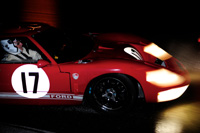 |
Why?
Having somehow managed to escape the typically fickle Spa weather in recent years, the Spa Six Hours saw some healthy repair bills flooding the paddock of this year's edition, along with the gushes of heavy rain tormenting the track and its occupants on Saturday evening and the whole of Sunday. It turned the 2010 event into a rather wet spectacle. The audience drowned themselves further in beer while watching the drivers brave the circumstances. Only the select group of winning drivers were happy to receive an additional amount of spray by spilling their triumphant bubbly.

Martin Stretton in stratospheric mood on the Six Hours podium. (photo 8W)
The intermittent rain played a decisive part in the outcome of several races. The first Grand Prix Masters was declared a wet race after a brief shower turned the circuit into a very slippery affair. At first, Bill Coombs and Richard Barber strode away on their wet-weather tyres but on the drying track the slick-shod Arrows A3 of Rob Austin quickly overhauled their Tyrrell 009 and Fittipaldi F5A. The next day, in torrential conditions, Austin showed he was equally apt on wets as he demolished the opposition in the few racing laps that were given to him after the race was started behind the safety car.
The same scenario unfolded in the main event on Saturday evening. The sun was shining at the four o’clock start of the Six Hours and initially the three Ford GT40s ran away with the race. At around eight, as night set in, a shower of epic proportions hit the valley. The Demon Tweeks E-type of Jon and Jason Minshaw and Martin Stretton had kept at close distance and pounced when the conditions shifted in their favour, allowing the trio to take a third win in the long-distance invitational, by now a modern classic among the ever-growing number of historic racing fixtures on the calendar.
Top-line historic racer Martin Stretton had started the race in the No.25 Tromans/Caine Cobra before doing the final stint in the No.9 Jag, probably not just to hedge his bets but also because he simply can’t get enough. It showed on the podium where Martin went centre-stage as he exploded with joy to almost the same amount as his champagne bottle. A few minutes earlier, the Minshaw pit had already seen a very British victory celebration with a firm hand-shake and the odd congratulatory slap on the shoulder. Next door, it was doom and gloom in the classy Lanzante pit. Last year’s winners Shaun Lynn and Andrew Haddon ran into trouble and could only manage 47th place in the end.
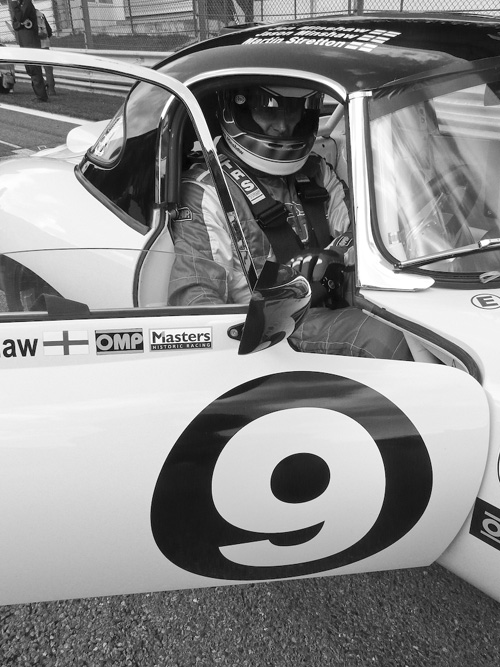
Ready for glory: Minshaw Sr has just lined up the winning E-type on the grid. (photo 8W)
More pictures of the pit and the grid
At the other end of the F1 pitlane, the DHG pit was equally philosophical. In 2009, David Hart, Rob Hall and pinch-hitter Jeroen Bleekemolen almost snatched a win from the ailing Lanzante GT40 but the Ford barely held on to wave off the Dutch Cobra challenge. Having switched to a Corvette this year, and with Nicky Pastorelli in the hot seat for the final stint, Hart had hoped to go one better. But while the Lanzante car failed to hang on this time, the Corvette wasn’t around to take profit, as it could only manage 7th place, beaten by the Voyazides/Hadfield and Meins/Lillingstone-Price GT40s remaining at the top end of the field, the Thornton/Garrett/Wilmott DB4 GT, the Cobra of the Bryants and the E-type of the Clarks.
The support programme included some 15 races, this time with quite a new emphasis on single-seaters. Compared to 2009, the programme saw the addition of mainly rear-engined F Juniors, fifties and sixties GP cars, and seventies and eighties F2 and F3 cars. These all turned in spectacular races, the Sunday splash through the gloomy Ardennes forest by the HGPCA field the undoubted highlight.
The fendered cars provided their part in the spectacle, too. From the 2-litre touring cars, gritty as ever, to the beautiful sports cars of the fifties competing in the Stirling Moss and RAC Woodcote Trophies, they all amply supplied us with sideways antics and close racing. On Sunday, the sports cars looked much more at ease with the wet conditions than the most powerful single-seaters, some of those even unable to keep up with the safety car. The second highlight of the weekend came at the end, however, with a second long-distance event, the two-hour Masters Gentleman Drivers race. It turned into a reprieve for the Hadfield/Voyazides crew who had lost out to the Minshaw Jag the night before. The pair took their Cobra to a win ahead of the similar car of the Bryant father and son combination.
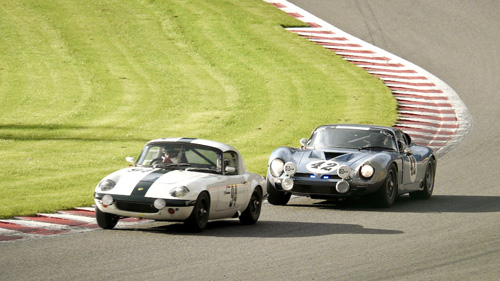
Roger Wills's Bizza harries Belgian-crewed Elan through Eau Rouge. (photo 8W)
More pictures of the Saturday and Sunday track action
As always, the paddock experience at the Six Hours was unequalled, as the Spa circuit’s fairly modest facilities do their best to evoke that carefree paddock atmosphere of the past. Even in the F1 pit building, lined by the expensive motorhomes and transporters brought by some of the better-funded teams, the impression is one of organised chaos. Or to put that differently – a chaotic form of order, since every team member still manages to find their way among the amazing variety of cars from multiple races spread around across the pit floor.
Further out in the arrow-shaped area between the two start-and-finish straights you can still get acquainted with the true nomadic existence of travelling from circuit to circuit in the hope of bagging enough start and prize money to make it to the following season. Compared to the high paddock standards in today’s top-flight single-seater and sportscar racing, let alone F1, this is your best shot at a flash into a past that really existed, in an event that is meant to be retro anyway.
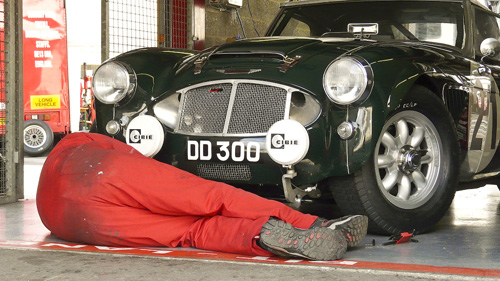
Final preparations on the Dutch Big Healey piloted by Le Blanc/Van Lanschot in the big event. (photo 8W)
More pictures of the paddock atmosphere
A visit to the Spa Six Hours is unfinished business without attempting a trek around the track. This year, we did two. The first one came during the middle part of the Six Hours race itself, as we walked into dusk by the time we had reached Pouhon. There, photographer Frank van de Velde took his most sensational pictures of the event, before repeating his night photography tricks at La Source on our return to the paddock.
That wasn’t until the mid-race deluge hit us at Fagnes. By now, it was pitch-dark. The trees lining the track amalgated into imposing black mountains, only showing their true identity when hit by the errant headlights of the cars still in competition and fighting it out on a circuit that at some places mimicked a river. The only way to see the cars was when they closely followed each other. We forgot to bring our raincoats, as we thought it wouldn’t rain until the next day, but we resisted the urge to run straight back to the paddock. After a short break in the Blanchimont tunnel, we experienced our finest hour as a Six Hours spectator – out on the circuit at night, the noisy symphony of endless engine variety providing the soundscape to the rain-beaten slopes of Spa’s natural arena.
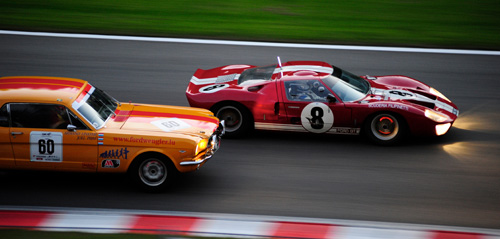
The run to Pouhon: Voyazides/Hadfield GT40 charges past Mustang from Luxembourg. (photo Frank van de Velde)
More of Frank van de Velde’s pictures of the event
A second day-time trek – this time armed with pukka rainsuits and umbrellas to give shelter to our photo equipment – proved to be equally satisfying. A drowned-out Rivage kept its promise as a men-from-boys sorter, as only the bravest of men dared applying the throttle before straightening out to plunge down to no-name corner and Pouhon. Further up ahead, a treacherous semi-wet Fagnes supplied us with numerous drifts, while the Bus Stop gave us more heroics in between the tip-toeing of the ordinary hard-triers. So next time you notice it is late September on your calendar, don’t think again. You wouldn’t want to be anywhere else.
